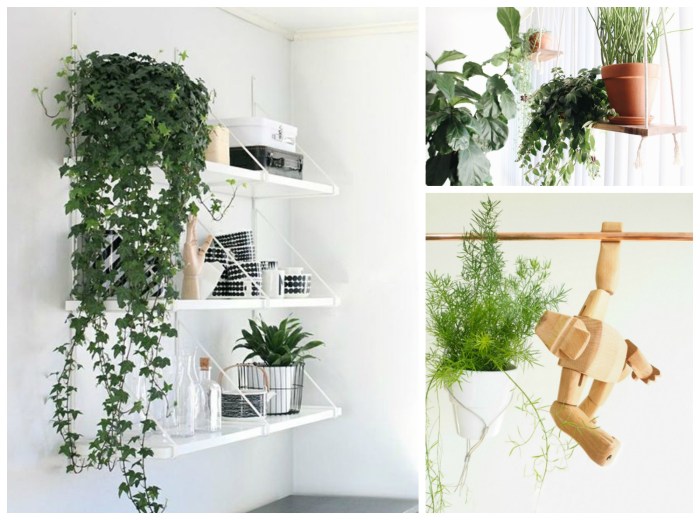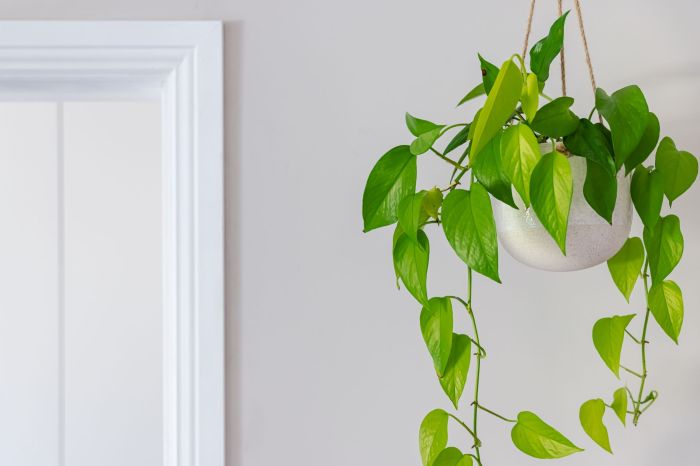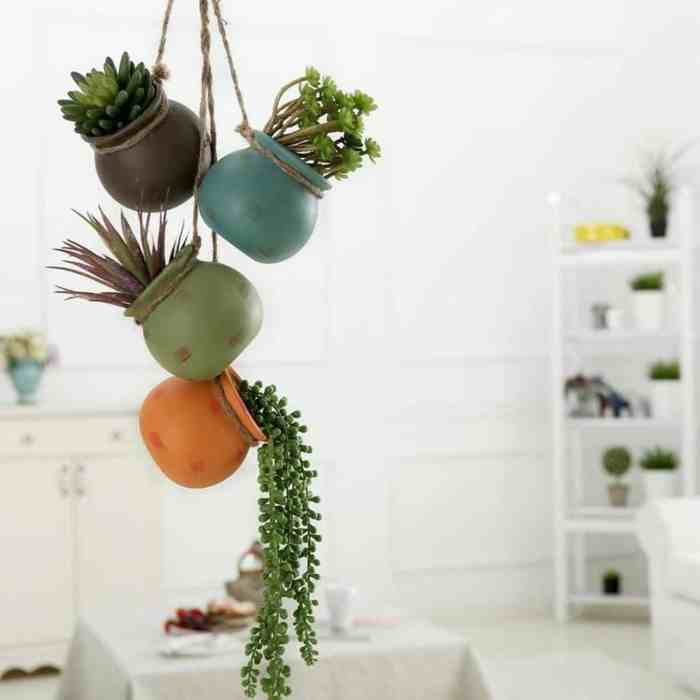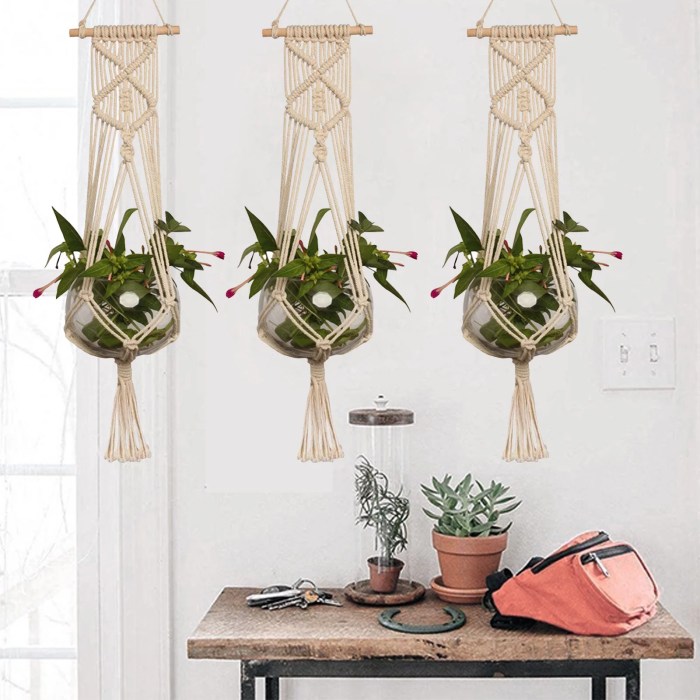Hanging down indoor plant – Hanging indoor plants have become increasingly popular, offering a unique way to add life and style to any space. From lush ferns to cascading vines, there are countless options to choose from, each with its own unique charm and care requirements.
In this comprehensive guide, we will delve into the world of hanging indoor plants, exploring their varieties, hanging methods, care considerations, aesthetic arrangements, and DIY projects. Whether you’re a seasoned plant enthusiast or just starting out, this guide will provide you with all the information you need to create a thriving indoor oasis.
Indoor Plant Varieties

Hanging indoor plants add a touch of greenery and elegance to any space. They can purify the air, reduce stress, and even boost creativity. There are many different varieties of hanging indoor plants to choose from, each with its own unique characteristics and care requirements.
Hanging down indoor plants are a great way to add a touch of nature to your home, and they can also help to improve air quality. One of the most popular types of hanging plants is the draping shelf plant , which is known for its long, flowing leaves.
Draping shelf plants are perfect for adding a touch of drama to a room, and they can also be used to create a sense of privacy. If you’re looking for a way to add some greenery to your home, a hanging down indoor plant is a great option.
Some of the most popular hanging indoor plants include:
- Spider plant( Chlorophytum comosum): Spider plants are easy to care for and can tolerate a wide range of conditions. They produce long, trailing stems with small, white flowers.
- Pothos( Epipremnum aureum): Pothos is another easy-care plant that is known for its long, trailing vines. It comes in a variety of leaf colors, including green, yellow, and white.
- Philodendron( Philodendron spp.): Philodendrons are a large genus of plants that includes many different varieties. They are typically characterized by their large, heart-shaped leaves.
- Ferns( Filicales): Ferns are a type of non-flowering plant that can add a touch of elegance to any space. They come in a variety of shapes and sizes, and some varieties can even tolerate low light conditions.
- String of pearls( Senecio rowleyanus): String of pearls is a unique plant that produces long, trailing stems with small, pearl-like leaves.
When choosing a hanging indoor plant, it is important to consider the amount of light and space you have available. You should also think about the type of care you are willing to provide. With a little research, you can find the perfect hanging indoor plant to add a touch of beauty and greenery to your home.
Hanging Methods

Hanging indoor plants is a great way to add greenery and style to your home. There are a variety of methods for hanging plants, each with its own advantages and disadvantages.
Macrame
Macrame is a type of knotting that can be used to create beautiful and unique plant hangers. Macrame hangers are relatively easy to make, and they can be customized to fit any style of décor.
To make a macrame plant hanger, you will need:
- Macrame cord
- Scissors
- A measuring tape
- A pot or planter
Once you have gathered your materials, you can follow these steps to make a macrame plant hanger:
- Cut a piece of macrame cord that is three times the length of the desired length of the hanger.
- Fold the cord in half and tie a knot at the top.
- Divide the cord into three equal strands.
- Tie a square knot with the left and middle strands.
- Tie a square knot with the right and middle strands.
- Repeat steps 4 and 5 until the hanger is the desired length.
- Tie a knot at the bottom of the hanger and trim the ends of the cord.
- Insert the pot or planter into the hanger and enjoy your new creation!
Hooks
Hooks are another popular method for hanging plants. Hooks are available in a variety of sizes and styles, so you can find one that will match your décor.
To hang a plant with a hook, simply screw the hook into the ceiling or wall and then hang the pot or planter from the hook.
Ceiling Mounts
Ceiling mounts are a great option for hanging plants in high-ceilinged rooms. Ceiling mounts are typically made of metal or plastic, and they can be installed by a professional or do-it-yourselfer.
To install a ceiling mount, you will need:
- A ceiling mount
- Screws
- A drill
Once you have gathered your materials, you can follow these steps to install a ceiling mount:
- Drill a hole in the ceiling where you want to install the ceiling mount.
- Insert the screws into the hole and tighten them until the ceiling mount is secure.
- Hang the pot or planter from the ceiling mount and enjoy your new hanging plant!
Plant Care Considerations

Hanging indoor plants require specific care to thrive in their suspended environment. Understanding their unique light, water, and humidity needs is crucial for maintaining optimal growth and health.
Light Requirements
Hanging plants’ light requirements vary depending on the species. Some plants, like spider plants and pothos, can tolerate low light conditions, while others, like succulents and cacti, prefer bright, indirect light. Research the specific light needs of each plant and provide the appropriate lighting conditions.
Water Requirements
Watering hanging plants can be tricky due to their elevated position. Overwatering can lead to root rot, while underwatering can stunt growth. Check the soil regularly for moisture and water when the top inch of soil feels dry to the touch.
Allow excess water to drain away to prevent waterlogging.
Hanging down indoor plants can add a touch of greenery and life to any room. If you’re looking for easy low light hanging plants, there are a few great options to choose from. Some of the most popular easy low light hanging plants include the pothos, the philodendron, and the spider plant.
These plants are all relatively easy to care for, and they can tolerate low light conditions. With a little care, they can add beauty and freshness to your home for years to come.
Humidity Requirements
Many hanging plants prefer higher humidity levels. To increase humidity around the plant, mist the leaves regularly or place a humidifier nearby. Grouping plants together can also create a more humid environment.
Aesthetic Arrangements

Hanging indoor plants offer a unique opportunity to create visually appealing arrangements that can enhance the ambiance of any room. By following a few simple principles of plant grouping and arrangement, you can achieve stunning results.
One important consideration is the size and shape of your plants. Larger plants should be placed at the back of the arrangement, while smaller plants can be used to fill in the foreground. This creates a sense of depth and interest.
Color and Texture
Another important factor to consider is the color and texture of your plants. Choose plants with complementary colors and textures to create a harmonious look. For example, you could pair a variegated plant with a solid-colored plant, or a plant with smooth leaves with a plant with textured leaves.
Hanging down indoor plants add a touch of greenery and freshness to any room. Among the most popular choices is the english ivy indoor hanging plant , known for its trailing vines and air-purifying qualities. These plants are relatively easy to care for, making them a great option for beginners.
They prefer bright, indirect light and should be watered regularly, allowing the soil to dry out slightly between waterings.
Arrangement Styles, Hanging down indoor plant
There are many different ways to arrange hanging plants. Some popular styles include:
- Vertical arrangement:This style involves hanging plants at different heights, creating a vertical cascade of greenery.
- Horizontal arrangement:This style involves hanging plants at the same height, creating a horizontal line of greenery.
- Mixed arrangement:This style involves combining different arrangement styles, such as hanging plants at different heights and in different directions.
The best way to choose an arrangement style is to consider the size and shape of your plants, the colors and textures of your plants, and the overall style of your room.
DIY Projects and Inspiration

Unleash your creativity and enhance your indoor space with unique hanging planters and macrame hangers. Discover a plethora of DIY projects and inspirational ideas to showcase your beloved plants in captivating ways.
Whether you prefer rustic charm or modern elegance, there’s a hanging solution that complements your décor. Experiment with different materials, textures, and designs to create custom planters that reflect your personal style.
DIY Hanging Planters
Embark on a rewarding journey of crafting your own hanging planters using simple materials and techniques. Transform wooden crates, metal buckets, or even old jars into stylish plant abodes. Add a touch of whimsy with painted designs, decoupage, or mosaic embellishments.
- Repurpose an old wooden crate by adding drainage holes and painting it in vibrant hues.
- Create a rustic planter by lining a metal bucket with burlap and suspending it with twine.
- Upcycle a glass jar by drilling holes for drainage and decorating it with intricate patterns using etching cream.
Macrame Plant Hangers
Embrace the art of macrame and weave intricate hangers that showcase your plants with bohemian flair. Using simple knots and cords, you can create elegant and durable hangers that add a touch of texture and warmth to your living space.
- Master the basic square knot and experiment with different patterns to create unique designs.
- Incorporate beads or wooden rings into your hangers for added visual interest.
- Use macrame cord in various colors and thicknesses to create a personalized look that complements your décor.
Inspirational Hanging Arrangements
Explore innovative ways to display your hanging plants and create stunning visual effects. Group similar plants together for a cohesive look or mix and match different species for a more eclectic arrangement.
Consider using staggered heights to create a dynamic display or suspend plants from different points on the ceiling for a dramatic impact. Incorporate mirrors or artwork into the arrangement to enhance the overall aesthetic appeal.
Summary: Hanging Down Indoor Plant

Hanging indoor plants are a versatile and beautiful way to bring nature into your home. With proper care and attention, they can thrive for years to come, adding a touch of greenery and freshness to your living space. So embrace the beauty of hanging plants and let them transform your home into a vibrant and inviting sanctuary.
Common Queries
What are the most popular hanging indoor plants?
Some of the most popular hanging indoor plants include pothos, spider plants, ferns, ivy, and succulents.
How do I hang indoor plants?
There are a variety of ways to hang indoor plants, including using macrame hangers, hooks, or ceiling mounts. The best method will depend on the type of plant and the desired look.
How often should I water hanging indoor plants?
The watering frequency for hanging indoor plants will vary depending on the type of plant and the growing conditions. In general, it is best to water when the soil is dry to the touch.